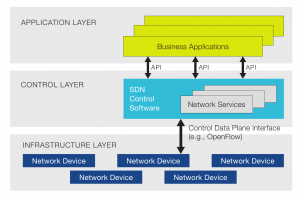Software-Defined Networking (SDN) is an architecture for computer networking. The overall key concept for SDN-based architecture is to define a control plane and a data plane. The control plane is represented as a server or appliance that takes the accountability for the communication between the business applications and the data plane. The data plane is represented by the network infrastructure where we don’t differ anymore between effective hardware and virtualized network devices. Thus, a control plane has to abstract the network for an administrator in both sides, the application and the infrastructure.

Currently there exists one SDN specification and related implementations for the communication between the data plane and the business applications which is called OpenFlow. OpenFlow does neither specify how the control plane is technically implemented nor how the network infrastructure is build, it is responsible for the communication of them. The standardizing of the elements in SDN were made by the Open Network Foundation (ONF) which is a non-profit industry consortium, working in close collaboration with OpenFlow. This circumstance lead to the general opinion that OpenFlow is the equivalent to SDN and that there is no limitation in what technology can be used in a SDN-based infrastructure.
As the architecture for SDN describes, the control plane is a single, abstracted entry point for network administrators what has the following advantages:
- Centralized control of different network infrastructure vendors
- Reduced complexity of newly added business applications and/or network devices
- More network reliability and security
- More granular network control of the incoming and outgoing network traffic
- A higher and less complex rate of automation
All these points cover the problems that big datacentre’s currently have from the perspective of the network infrastructure. But what about the really small networks, for example a home-network. Does it make sense to separate the control and the data plane from each other if you have only one router/modem with 2 computers connected to it? The Answer is: Think big. Why do we have to manage the router/modem in the home-network by ourselves? In future times, this may be a task for the Internet Service Provider who is doing this today in some way anyways. The benefit for the ISP and the end-user is clear, less support tickets means happier end-users and a smaller support effort for the ISP itself.
We at the ICCLab have realised that we are having in our OpenStack Cluster problems that can be solved easily with a SDN architecture for our internal network infrastructure. If you are interested in some of the experiences we have made with SDN, we will publish soon an article how we setup our test-environment
[1] Software-Defined Networking: The New Norm for Networks
3 Kommentare